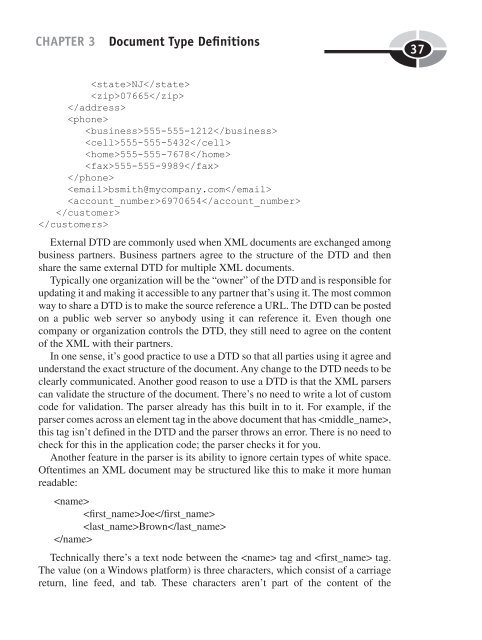You also want an ePaper? Increase the reach of your titles
YUMPU automatically turns print PDFs into web optimized ePapers that Google loves.
CHAPTER 3 Document Type Defi nitions<br />
NJ<br />
07665<br />
<br />
<br />
555-555-1212<br />
555-555-5432<br />
555-555-7678<br />
555-555-9989<br />
<br />
bsmith@mycompany.com<br />
6970654<br />
<br />
<br />
External DTD are commonly used when <strong>XML</strong> documents are exchanged among<br />
business partners. Business partners agree to the structure of the DTD and then<br />
share the same external DTD for multiple <strong>XML</strong> documents.<br />
Typically one organization will be the “owner” of the DTD and is responsible for<br />
updating it and making it accessible to any partner that’s using it. The most common<br />
way to share a DTD is to make the source reference a URL. The DTD can be posted<br />
on a public web server so anybody using it can reference it. Even though one<br />
company or organization controls the DTD, they still need to agree on the content<br />
of the <strong>XML</strong> with their partners.<br />
In one sense, it’s good practice to use a DTD so that all parties using it agree and<br />
understand the exact structure of the document. Any change to the DTD needs to be<br />
clearly communicated. Another good reason to use a DTD is that the <strong>XML</strong> parsers<br />
can validate the structure of the document. There’s no need to write a lot of custom<br />
code for validation. The parser already has this built in to it. For example, if the<br />
parser comes across an element tag in the above document that has ,<br />
this tag isn’t defined in the DTD and the parser throws an error. There is no need to<br />
check for this in the application code; the parser checks it for you.<br />
Another feature in the parser is its ability to ignore certain types of white space.<br />
Oftentimes an <strong>XML</strong> document may be structured like this to make it more human<br />
readable:<br />
<br />
Joe<br />
Brown<br />
<br />
Technically there’s a text node between the tag and tag.<br />
The value (on a Windows platform) is three characters, which consist of a carriage<br />
return, line feed, and tab. These characters aren’t part of the content of the<br />
37


